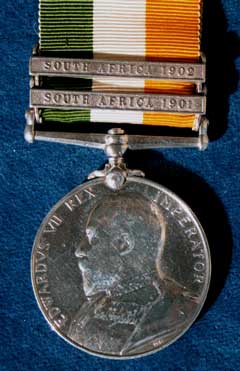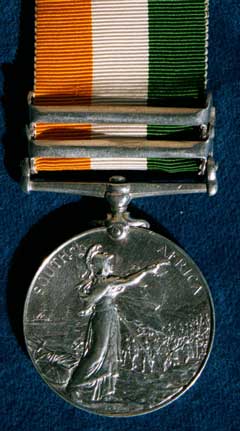MEDAL INFORMATION
King’s South Africa Medal
(Jan 1901 - May 1902)
Face
The Uniformed bust of
King Edward VII surrounded by the legend: “EDWARDVS VII REX IMPERATOR”.
Reverse
The standing figure of
Britannia with a flag in her left hand, her right arm extended holding a
laurel wreath towards an advancing body of troops. Two warships are in
the background. Around the top are the words “SOUTH AFRICA”.
Size
Approx. 36 mm in
diameter.
Composition
The medal and bars are
of silver.
Ribbon
Approx. 32 mm wide.
Green, white and orange stripes reading from left to right, as seen, and
all of equal width.
Suspension
The ribbon passes
through a plain, straight, swivelling suspender.
Naming
Generally in indented
block capitals and giving Number, Rank, Initials, Surname, and Unit. In
the case of medals to men of The King’s Own the unit is inscribed; “RL:LANC:REGT.”
Bars
Two - SOUTH AFRICA
1901 and SOUTH AFRICA 1902.
Awarded
Queen Victoria died in
January 1901 during the course of the South African (Boer) War and was
succeeded on the throne by her son, King Edward VII, who instituted this
medal. It was awarded to all who were serving in South Africa on or after
1 January 1902 and who completed eighteen months service in South Africa
on or before 31 May 1902. The medal was never issued alone, but always
along with the Queen’s South Africa medal. The time qualification of
eighteen months did not need to be continuous; anyone who failed to
qualify for the “1901” Bar because of wounds or illness and returned to
South Africa in 1902 to complete the requisite service by 31 May qualified
for the bar “South Africa 1902”. Most of the medals issued bore both
bars, but about 590 medals without a bar were issued to nurses who served
in South Africa during the war. Although there were no ‘battle’ bars
awarded with this medal it does commemorate almost two years of guerrilla
warfare after the Boer surrenders of late 1900 during which many
casualties were suffered.
The King’s Own
Although officers and
men of the 1st and 2nd Battalions of The King’s Own Royal Lancaster
Regiment (the Regulars), the 3rd and 4th (Militia) Battalions and the
Active Service Companies of the 1st and 2nd (Volunteer) Battalions (all
part time soldiers) served in South Africa between 1900 and 1902, only
those of the 2nd Battalion and 3rd Militia Battalions qualified for the
King’s South Africa medal by serving through from 1900 to 1902. Those of
the 1st Battalion who went to South Africa served as specially trained
Mounted Infantry to counter the Boers mounted guerrilla tactics and did
not go out until 1901, whilst the 4th (Militia) Battalion went out in
January 1900 and returned to England in August 1901 and the Volunteer
Service Companies each served abroad for a limited period of about one
year. Those in the various Mounted Infantry Companies served far and wide
in the ‘drives’ to round up and disarm the thousands of Boer horsemen
still in the field in 1901, whilst the conventional infantry units
operated Kitchener’s ‘Blockhouse System’ whereby the vast areas of open
country were divided up into enclosed areas of manageable size by lines of
strongly fortified buildings about fifteen feet in diameter at intervals
of about one mile. Each of the blockhouses was manned by about six men
and a non-commissioned officer, and at salient points was a larger
blockhouse with a garrison of about twenty five men and an officer. It
was the combination of the use of mounted troops and the blockhouse system
which led to the final defeat of the Boers.
King's South African Medals in the museum's
collection.


King's South Africa Medal



